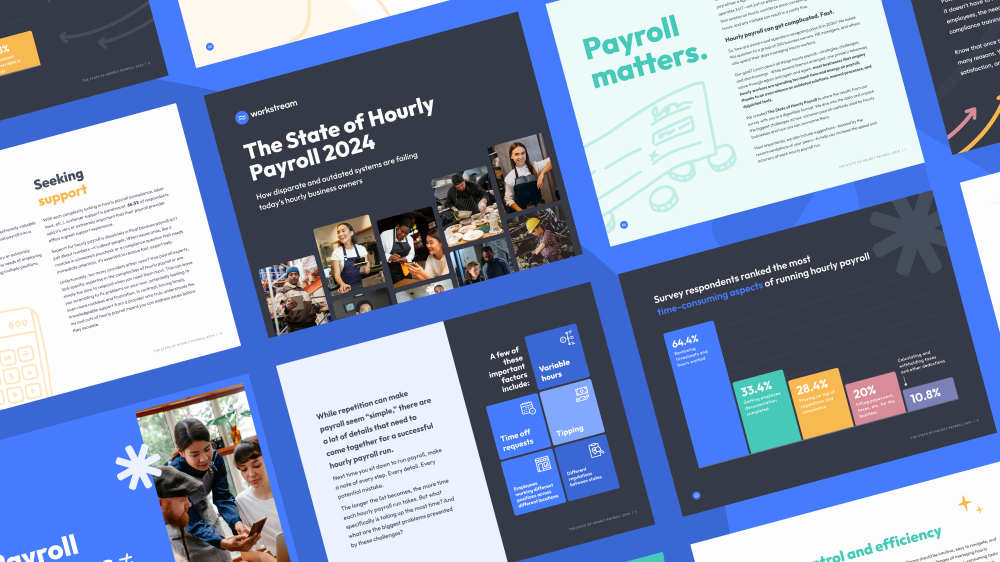Subscribe to our newsletter
Unlock your team’s financial literacy: An employee’s guide to Form W-4
Download the guide
Chapters:
- Employer introduction
- Employee introduction
- A quick overview
- Step 1: Enter personal information
- Step 2: Multiple jobs or spouse works
- Step 3: Claim dependents and other credits
- Step 4: Other adjustments
- Step 5: Sign here
- In summary
Download the guide
Get the latest with Workstream
Always stay current with hiring news by subscribing to our email updates
Employer introduction
Empowering your employees with the knowledge and tools they need to navigate Form W-4 can have a significant impact on their financial well-being and your business's bottom line. That's why we've created this comprehensive guide specifically tailored for hourly workers. By equipping your team with the understanding of what Form W-4 is and how to fill it out correctly, you can improve retention, boost morale, and enhance overall job satisfaction.
Share this post with your team, or download the PDF above to share.
Employee introduction
Disclaimer: These materials are intended to provide you with general information, including guidance on completing Form W-4, and are not intended as tax or legal advice. Accordingly, as each individual’s employment and tax circumstances may vary, these materials may not address your unique situation. We encourage you to consult with your tax professional or attorney or seek guidance from your relevant taxing authority to ensure your compliance with applicable laws and regulations. As tax laws vary by jurisdiction and change over time, please consult with your professional advisor or appropriate governmental agency before making any filings or financial planning decisions.
So, you just started your first job, or you recently changed jobs. Congratulations! Before you begin working for your new employer, you’ll be asked to complete Form W-4. How you fill out your W-4 determines how much of your money is withheld for taxes on every paycheck.
You may also need to update Form W-4 when a significant change happens in your life—like the birth (or adoption) of a child, getting married or divorced, starting a business, or getting a second job.
In fact, any time your personal or financial situation changes, consider completing a new W-4. It helps to make sure that your employer withholds the correct federal income tax from your pay. If too much is withheld, you’ll likely be owed a refund. However, when too little is withheld, you’ll likely owe money when you file your tax return—along with a penalty if you can’t pay on time.
This is why it’s important to understand the W-4 so you can fill it out as accurately as possible.
A quick overview
For many of us, filling out Form W-4 is usually a simple, straightforward process. For example, if you're single (or married to a partner who doesn't work), only have one job, and aren't planning on claiming tax credits beyond the standard deduction, completing the W-4 is as easy as filling in your name, address, social security number, and filing status—all before you sign and date it.
However, if you have a spouse who also works, plan to claim any dependents (such as your children), or have income (not from jobs) like stock dividends, it gets more complicated.
Whatever your situation, everyone can benefit from a breakdown (or refresher) of the Form W-4.
Let's go over it step by step. Starting with...
Step 1: Enter personal information
This is the section where you provide much of the same information you did back when you first applied for your job—starting with first name, middle initial, and last name. Your employer needs a social security number so the money they withhold from your pay throughout the year can be sent directly to the IRS and applied to your annual income tax bill. The next part is filing status.
If you’re single (or married filing separately), all that’s left for you to do is skip ahead to Step 5 to sign and date your W-4. Then you’re done! Everyone else needs to complete Steps 2 through 4.
Step 2: Multiple jobs or spouse works
If you’ve proceeded to this step, it means you hold more than one job at a time or you’re married and filing jointly with a spouse who also works. This leaves you with one choice of three options:
- Option (a): If you or your spouse have self-employment income, use the Tax Withholding Estimator Tool* to calculate how much federal income tax you want your employer to withhold from your check. This estimate is only as accurate as the information provided, so be sure you have your other income info handy (including your spouse’s) as needed.
- Option (b): If you and your spouse have three or more jobs combined, the Multiple Jobs Worksheet on page 3 of the W-4 will need to be used. For accurate withholding, only complete this worksheet if you're the spouse in your couple with the higher-paying job.
- Option (c): If there are only two jobs total between you and your spouse, use this option. You’ll want to do the same on the W-4 for the other job. Option C is more accurate than Option B if the pay at the lower-paying job is more than half that of the higher-paying job.
*www.irs.gov/individuals/tax-withholding-estimator
Remember, when you move forward to Steps 3-4(b) on your Form W-4, only fill out those steps for ONE of your jobs (the higher-paying one). Leave those steps blank for all of the other jobs.
Step 3: Claim dependents and other credits
If you have dependents and your total income is $200,000 or less ($400,000 or less if married and filing jointly), you may qualify to claim dependents and lower your tax liability. This usually takes the form of the Child Tax Credit for each qualifying dependent child under the age of 17.
Qualifying dependents can also be any direct relative, in-law, or foster child whose gross income is less than $5,500 and who you provide at least half their financial support throughout the year.
On this step of the W-4, you’re instructed how to calculate your tax credits—totaling from $2,000 for each qualifying child under age 17 and $500 for each of your other qualifying dependents.
Step 4: Other adjustments
This is the section of the W-4 where you can opt to have your employer withhold additional pay from your paycheck. If you have extra sources of income, this is where you make sure enough pay is being withheld so you can avoid underpayment penalties or a surprise tax bill next April.
-
Line 4 (a) is for people who earn "non-job" income that isn't subjected to withholding throughout the year—such as retirement income or dividends from investments.
-
Line 4 (b) is for deductions itemized using the Deductions Worksheet on page 3—like mortgage interest, charitable deductions, or medical costs over 7.5% of your income.
-
Line 4 (c) is for any additional tax you want withheld from your pay throughout the year.
Step 5: Sign here
This step is self-explanatory. Make the form valid with your signature and the date you signed it.
In summary
All employees are required to fill out a W-4 with their employer so they can withhold money from your paycheck for federal taxes with the IRS. The form only needs to be filled out when you start a new job or have a big life change like getting married, having a child, or landing a second job.
Fill out the form as accurately as possible—paying attention to any deductions or tax credits you may qualify for or taking note if you need extra money withheld to avoid a tax bill next April. Keep this guide as a resource for the next time you need to fill out or update your W-4.
TAGS
Workstream
Workstream is the leading HR, Payroll, and Hiring platform for the hourly workforce. Its smart technology streamlines HR tasks so franchise and business owners can move fast, reduce labor costs, and simplify operations—all in one place. 46 of the top 50 quick-service restaurant brands—including Burger King, Jimmy John’s, Taco Bell—rely on Workstream to hire, retain, and pay their teams. Learn how you can better manage your hourly workforce with Workstream.


